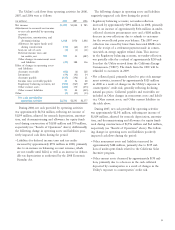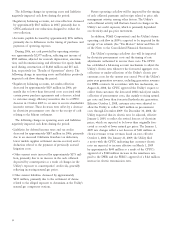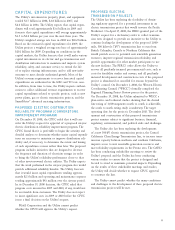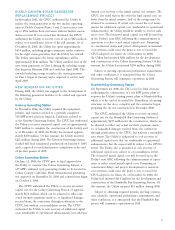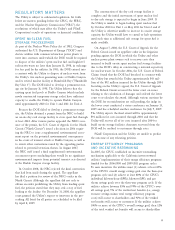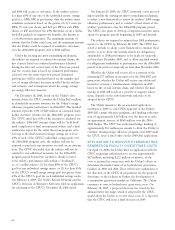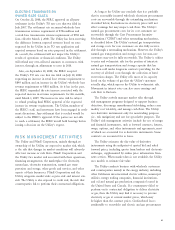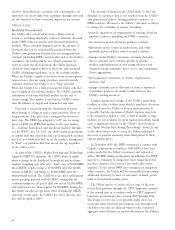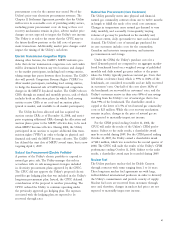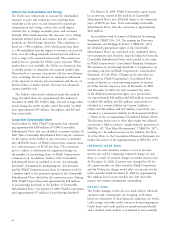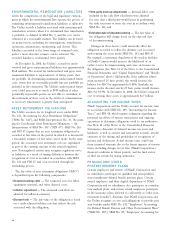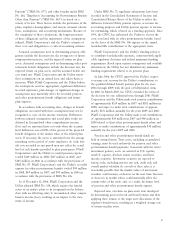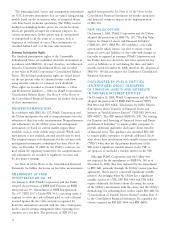PG&E 2008 Annual Report Download - page 63
Download and view the complete annual report
Please find page 63 of the 2008 PG&E annual report below. You can navigate through the pages in the report by either clicking on the pages listed below, or by using the keyword search tool below to find specific information within the annual report.61
As long as the Utility can conclude that it is probable
that its reasonably incurred wholesale electricity procurement
costs are recoverable through the ratemaking mechanism
described below, fl uctuations in electricity prices will not
affect earnings but may impact cash fl ows. The Utility’s
natural gas procurement costs for its core customers are
recoverable through the Core Procurement Incentive
Mechanism (“CPIM”) and other ratemaking mechanisms,
as described below. The Utility’s natural gas transportation
and storage costs for core customers are also fully recover-
able through a ratemaking mechanism. However, the Utility’s
natural gas transportation and storage costs for non-core
customers may not be fully recoverable. The Utility is subject
to price and volumetric risk for the portion of intrastate
natural gas transportation and storage capacity that has
not been sold under long-term contracts providing for the
recovery of all fi xed costs through the collection of fi xed
reservation charges. The Utility sells most of its capacity
based on the volume of gas that the Utility’s customers
actually ship, which exposes the Utility to volumetric risk.
Movement in interest rates can also cause earnings and
cash fl ow to fl uctuate.
The Utility actively manages market risks through
risk management programs designed to support business
objectives, discourage unauthorized risk-taking, reduce com-
modity cost volatility, and manage cash fl ows. The Utility
uses derivative instruments only for non-trading purposes
(i.e., risk mitigation) and not for speculative purposes. The
Utility’s risk management activities include the use of energy
and fi nancial instruments, such as forward contracts, futures,
swaps, options, and other instruments and agreements, most
of which are accounted for as derivative instruments. Some
contracts are accounted for as leases.
The Utility estimates the fair value of derivative
instruments using the midpoint of quoted bid and asked
forward prices, including quotes from brokers and electronic
exchanges, supplemented by online price information from
news services. When market data is not available, the Utility
uses models to estimate fair value.
The Utility conducts business with wholesale customers
and counterparties mainly in the energy industry, including
other California investor-owned electric utilities, municipal
utilities, energy trading companies, fi nancial institutions,
and oil and natural gas production companies located in
the United States and Canada. If a counterparty failed to
perform on its contractual obligation to deliver electricity
or gas, then the Utility may fi nd it necessary to procure
electricity or gas at current market prices, which may
be higher than the contract prices. Credit-related losses
attributable to receivables and electric and gas procurement
ELECTRIC TRANSMISSION
OWNER RATE CASES
On October 22, 2008, the FERC approved an all-party
settlement in the Utility’s TO rate case that was fi led in
July 2007. The settlement sets an annual wholesale base
transmission revenue requirement of $706 million and
a retail base transmission revenue requirement of $718 mil-
lion, effective March 1, 2008. The Utility has been reserving
the difference between expected revenues based on rates
requested by the Utility in its TO rate application and
expected revenues based on rates proposed in the settlement.
As a result, the settlement will not impact the Utility’s
results of operations or fi nancial condition. The Utility
will refund any over-collected amounts to customers, with
interest, through an adjustment to rates in 2010.
Also, on September 30, 2008, the FERC accepted
the Utility’s TO rate case that was fi led on July 30, 2008
requesting an increase in retail base revenue requirement to
$849 million and an increase in the Utility’s wholesale base
revenue requirement to $838 million. As it has in the past,
the FERC suspended the rate increase associated with the
requested increase in revenue requirements for fi ve months,
until March 1, 2009. The increase in rates will be subject
to refund pending fi nal FERC approval of the requested
increase in revenue requirements. The Utility, members of
the FERC’s staff, and interveners have been engaged in settle-
ment discussions. Any settlement that is reached would be
subject to the FERC’s approval. If the parties are not able
to reach a settlement, the FERC would hold hearings before
issuing a decision on the Utility’s request.
RISK MANAGEMENT ACTIVITIES
The Utility and PG&E Corporation, mainly through its
ownership of the Utility, are exposed to market risk, which
is the risk that changes in market conditions will adversely
affect net income or cash fl ows. PG&E Corporation and
the Utility face market risk associated with their operations,
fi nancing arrangements, the marketplace for electricity,
natural gas, electricity transmission, natural gas trans-
portation and storage, other goods and services, and other
aspects of their businesses. PG&E Corporation and the
Utility categorize market risks as price risk and interest rate
risk. The Utility is also exposed to credit risk, the risk that
counterparties fail to perform their contractual obligations.


